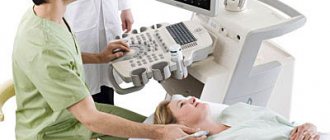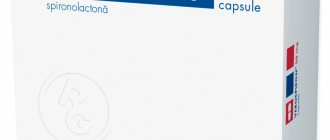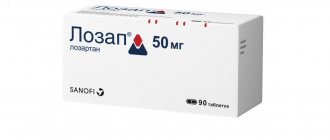Pharmacological properties of the drug Asparkam
Pharmacodynamics . Asparkam has antiarrhythmic properties, replenishes the deficiency of magnesium and potassium ions. Magnesium activates Na+K+/ATPase, as a result of which the intracellular sodium content decreases and the flow of potassium into the cell increases. When the sodium concentration in the cell decreases, the sodium-calcium exchange of vascular smooth muscles is inhibited, which leads to their relaxation, potassium ions stimulate the synthesis of ATP, glycogen, proteins, acetylcholine; Potassium and magnesium support the polarization of cell membranes. Aspartate promotes the entry of ions into the cell and takes part in energy metabolism. The antiarrhythmic effect is realized due to the ability of the drug to eliminate electrolyte imbalance and reduce the excitability and conductivity of the myocardium. The pharmacokinetics of the drug has not been studied.
Adverse reactions and overdose
Non-standard symptoms appear in exceptional cases. Treatment with Asparkam can provoke:
- attacks of nausea with vomiting, dyspepsia, pain in the epigastric region, bleeding and ulcers of the gastrointestinal tract, drying of the mucous membranes in the oral cavity;
- problems with myocardial conduction, drop in blood pressure, atrioventricular block;
- convulsive states, sensitivity disorders with tingling and sensations of ants moving on the skin, decreased sensitivity of muscles to irritants;
- hyperemia of the facial dermis, skin rashes, obsessive itching;
- respiratory depression due to excess magnesium, hot flashes.
Clinical studies have not shown the presence of overdoses. If the recommended volume of the drug is accidentally increased, non-standard symptoms may appear:
- attacks of vomiting with nausea, digestive disorders;
- pain in the abdomen, the appearance of a metallic taste in the mouth;
- slow heartbeat, weakness, spatial disorientation;
- muscle paralysis, decreased sensitivity of the limbs;
- hyperemia of the facial skin, constant thirst;
- drops in blood pressure, disturbances in neuromuscular transmission, decreased muscle sensitivity;
- arrhythmic and convulsive conditions.
Symptomatic treatment consists of intravenous administration of calcium chloride. In difficult cases, the patient is sent for hemodialysis.
Indications for use of the drug Asparkam
Pills. In conditions accompanied by hypokalemia and hypomagnesemia (including overdose of saluretics); for cardiac arrhythmias, including those caused by the toxic effects of digitalis drugs (as part of combination therapy). Solution for injections . As part of complex therapy for heart failure, myocardial infarction, cardiac arrhythmias (mainly ventricular arrhythmias); - to improve the tolerability of cardiac glycosides.
Composition, indications and contraindications for therapy with Asparkam
The instructions for the drug indicate the following components:
- magnesium aspartate – 175 mg;
- potassium aspartate – 175 mg;
- corn starch;
- calcium salt and stearic acid;
- food additive E433;
- talc.
The weight of one tablet is 0.5 g.
Asparkam is a source of potassium with magnesium and is prescribed to patients with chronic cardiac pathologies, including insufficient organ functionality and the period after a heart attack, with arrhythmias. The medication complements therapy with digitalis preparations.
The medication is prohibited for use under certain conditions:
- for acute and chronic renal dysfunction;
- hypocorticism;
- 2-3 degrees of atrioventricular block;
- left ventricular failure and a drop in blood pressure below 90 units.
Asparkam is not prescribed to patients with individual intolerance to the component composition.
Use of the drug Asparkam
Pills. Prescribed orally for adults, 1-2 tablets 3 times a day after meals. The course of treatment is 3–4 weeks. The solution for injection is administered only intravenously. First, the contents of 1–2 ampoules of 10 ml or 2–4 ampoules of 5 ml are diluted in 100–200 ml of sterile water for injection or 5% glucose solution and administered at a rate of 25 drops/min. A single dose of Asparkam is 10–20 ml. If necessary, repeated administration is possible after 4–6 hours. For IV jet administration (at a rate of no more than 5 ml/min), the contents of 2 ampoules of 5 ml are diluted in 20 ml of sterile water for injection or 5% glucose solution. The course of treatment is 5 days.
Instructions for use of "Asparkam"
In the human body, harmonious functioning of systems is possible provided that electrolyte balance is maintained, balance between cations and anions in the blood plasma and extracellular space.
Potassium (K+) and magnesium (Mg 2+) are key intracellular electrolytes that regulate enzymatic activity and membrane potential. They belong to the group of cations (positively charged ions), which also includes sodium and calcium.
Action of elements:
- maintain blood plasma osmolarity (concentration of kinetically active particles) and electrolyte balance;
- ensure the movement of water molecules through blood vessels into tissues;
- create a certain concentration of dissolved substances (salts, bicarbonates, phosphates and acids);
- activate enzymatic reactions;
- ensure constant blood pH.
Potassium and magnesium deficiency is manifested by disorders of the cardiovascular system. The body’s self-regulation is disrupted, an imbalance of substances between cells and the intercellular space develops, which is accompanied by:
- deterioration of nerve and electromuscular conduction;
- rhythm disorder;
- myocardial dysfunctions.
To correct the electrolyte ratio, medications based on cation-anion mixtures are actively used. The drug "Asparkam" is represented by a balanced complex of D- and L-isomers of magnesium and potassium aspartate. Numerous medical studies have confirmed that such drugs can restore electrolyte balance, prevent new cases of arrhythmia, angina attacks, and improve the patient’s quality of life.
"Asparkam" is used in therapeutic and cardiological practice. In addition, the medicine is intended for:
- eliminating sore throat in athletes;
- reducing stress on the heart during bodybuilding;
- replenishing the deficiency of important microelements in children and adults, including pregnant women.
Indications
The use of the drug is indicated for the following conditions:
- laboratory confirmed hypokalemia, hypomagnesemia;
- chronic heart failure (CHF);
- coronary heart disease (CHD);
- condition after myocardial infarction (MI);
- shock, which is accompanied by loss of microelements (hypovolemic with hypoosmolarity of the blood);
- for smokers and the elderly to normalize metabolism and reduce the risk of coronary artery disease;
- acute loss of fluid (prolonged vomiting, diarrhea), polyuria;
- hyperaldosteronism syndrome with damage to the adrenal cortex or a secondary disorder of hormone secretion;
- overdose of cardiac glycosides (digitalis intoxication);
- arrhythmias: ventricular extrasystole, paroxysmal form of atrial fibrillation;
- for the prevention and correction of overtraining, increasing energy reserves in professional athletes and bodybuilders.
“Asparkam” is often prescribed in the complex therapy of chronic cardiac pathology, however, the use of cationic mixtures is not justified in all cases. An imbalance of key intracellular electrolytes provokes serious disturbances of homeostasis, lability of the level of microelements (sodium, chlorine and calcium) in the blood and extracellular space.
It is necessary to monitor the level of magnesium and potassium in the blood before and during treatment. This will prevent adverse reactions and minimize the risk of hyperkalemia with respiratory failure, muscle weakness, paresis and fatal arrhythmias.
Composition, dosage and release form
"Asparkam" is available in tablet and injection form for intravenous administration.
Release forms with the dosage of the active substance are presented in the table.
| Form | Magnesium aspartate (mg) | Potassium aspartate (mg) |
| Tablets (10, 20 and 50 per pack) | 175 | 175 |
| Ampoules of 5 and 10 ml | 40 (in 1 ml) | 45 (in 1 ml) |
| Solution for infusion (400 ml bottles) | 1100 (in 1 l) | 7900 (in 1 l) |
Previously, the drug from a domestic manufacturer was produced in ampoules of 20 ml, with a high content of cations in the solution (900 mg of potassium and 800 mg of magnesium).
Mechanism of action and properties: what is Asparkam used for?
Deviations in the metabolism of macro- and microelements are a serious problem, since they maintain balance in the body, determine the membrane transition potential and the activity of enzyme systems. In recent decades, doctors have been actively discussing methods for correcting such disorders.
Aspartate is involved in the process of restoring balance: it transports cations, ensures the delivery of K+ and Mg 2+ from the extracellular space into cells, participates in the metabolic process and improves the bioavailability of substances.
What is the drug prescribed for:
- Elimination of potassium imbalance, improvement of neuromuscular conduction, regulation of fiber contractions and cardiac activity.
- K+ has a moderate chronotropic effect: it normalizes the heart rate and rhythm, reduces the strength and excitability of the myocardium during arrhythmia.
- Combined intake with Mg 2+ increases energy reserves and accelerates metabolism by stimulating the synthesis and release of ATP. As a result, the well-being and tolerance to physical activity improves in patients with coronary artery disease, frequent attacks of angina pectoris, and in athletes with overtraining.
- With confirmed ion deficiency, taking Asparkam reduces the frequency of tachycardia paroxysms, supraventricular and ventricular extrasystole.
Taking diuretic drugs (Furosemide, Torasemide), digitalis preparations (Digoxin, Strophanthin, Korglykon), antibiotics and cytostatics causes hypokalemia, which results in the development of compensatory magnesium deficiency. Taking Asparkam eliminates electrolyte imbalance and side pharmacological effects from taking medications.
Admission rules: when, how and how much
The drug "Asparkam" can be purchased at a pharmacy without a prescription. It is not recommended to take the medicine without your doctor's knowledge.
With normal or elevated levels of K+ and Mg 2+ in the blood, taking a cationic solution provokes a state of hyperkalemia with excess magnesium and characteristic side effects. In complex treatment regimens, the medication is prescribed by general doctors (internists or family doctors), cardiologists or neurologists.
Pills
Rules for taking the tablet form of the medication:
- tablets are intended for oral use;
- should be taken with sufficient amount of water;
- dosage for persons over 18 years of age: 1–2 tablets 3 times a day;
- in case of severe lack of macroelements (laboratory confirmed) up to 3 tablets 3 times a day;
- It is recommended to take 20–40 minutes after meals (under the influence of the aggressive acidic environment of the stomach, the effectiveness is reduced by 20–35%).
Ampoules
The solution for intravenous administration is available in ampoules of 5 and 10 ml or in bottles (packages) of 400 ml for installation in an infusion pump or on a dropper stand. Rules of application:
- the medicine is injected slowly (in a stream) into the cubital vein;
- the drug is first added to 100–200 ml of saline or 5% glucose solution;
- injection rate: 2–5 ml per minute;
- for drip administration of Asparkam, add 0.9% sodium chloride or 5% glucose to a physiological solution;
- the course of treatment is 7–14 days (the drug begins to act after sufficient accumulation of ions in the tissues).
An adult is administered 10–20 ml of Asparkam (2 ampoules of 10 ml, or 4 of 5 ml). Drop 1-2 times a day, slowly, for an hour. The infusion pump or dropper is set at a rate of 25–30 drops per minute. Rapid administration is dangerous by the development of fatal arrhythmia.
Contraindications and adverse reactions
“Asparkam” is not recommended for use when:
- hypersensitivity to the components of the drug;
- allergies to sorbitol, fructose intolerance;
- impaired renal function (acute and chronic failure);
- AV heart block (atrioventricular) 1–3 degrees;
- severe myasthenia gravis;
- laboratory confirmed hyperkalemia, hypermagnesemia;
- metabolic or respiratory acidosis;
- pathologies of blood clotting (coaguloatia);
- massive burns, mechanical and other tissue damage.
Normally, the content of cations in the blood of an adult is 3.8–5.2 mmol/l for potassium, and 0.8–1.1 mmol/l for magnesium.
Symptoms of overdose with cationic solutions are presented in the table.
| Group of violations | Signs |
| Are common |
|
| Skin |
|
| Digestive tract |
|
Dependence of clinical signs on the level of electrolytes in the blood:
- Hyperkalemia: More than 5.5 mmol/l: significant muscle weakness, paresis or paralysis with respiratory failure. The excretion of ammonia and hydrogen by the kidneys worsens, and metabolic acidosis develops.
- More than 7.5 mmol/l is a danger for heart automaticity. The electrocardiogram shows sharp T waves, prolongation of the PQ interval and expansion of the ventricular complex (against the background of a slowdown in the conduction of impulses through the atrioventricular node). In the absence of emergency care, there is a risk of developing fibrillation and cardiac arrest. 10% calcium gluconate is administered as an antidote, and general rehydration is carried out (intravenously - up to 1 liter of saline).
- More than 2.5 mmol/l: lethargy, loss of orientation in space, drowsiness, decreased reflexes, depressed nervous activity.
Resuscitation measures include the administration of large volumes of fluid, elimination of hyperkalemia and hypermagnesemia with an injection of calcium chloride, “Insulin” 10–15 units per 100 ml of 40% glucose, and hemodialysis.
Using Asparkam with diuretics (Eplerenone, Spironaloctone) increases the risk of hyperkalemia. In combination with glycosides, it reduces sensitivity to them.
Use during pregnancy
During pregnancy, the drug is taken strictly as prescribed by the doctor. "Asparkam" is not recommended for women in the 1st and 2nd trimester. The exception is cases of severe toxicosis with edema, vomiting, nausea, and laboratory confirmed disorders. In such situations, the drug is prescribed if the benefit of the drug outweighs the harm.
Cationic solutions are indicated for convulsions, nervous twitching, and weakness during pregnancy. Intravenous administration is performed in a hospital setting under the supervision of a medical professional. Caution is necessary to minimize the risk of complications in mother and child.
Special instructions for the use of the drug Asparkam
With prolonged use of the drug, it is necessary to monitor the level of potassium and magnesium in the blood serum, and constant monitoring of ECG data is also necessary. Rapid intravenous administration of the drug Asparkam is contraindicated. With rapid intravenous administration of the drug, hyperkalemia and hypermagnesemia may develop, which can lead to arrhythmia, which poses a threat to the patient's life. With rapid intravenous administration, skin hyperemia may develop. Asparkam should be used with caution in AV blockade of II–III degree. Use during pregnancy and breastfeeding. The use of the drug during pregnancy is possible only if the expected benefit to the woman outweighs the potential risk to the fetus. If the drug is used during breastfeeding, it is recommended to stop breastfeeding. Children. There are no data on the use of the drug for the treatment of children, so the drug is not used in pediatric practice. The ability to influence reaction speed when driving vehicles or working with other mechanisms. Asparkam does not affect the reaction rate when driving vehicles or working with other mechanisms.
“Asparkam” in sports: how and why they use the product
The official instructions for Asparkam indicate that the drug is indicated for replenishing potassium and magnesium deficiency. In athletes, this condition develops after prolonged grueling training. The drug is taken to normalize the balance of electrolytes, maintain heart function under conditions of increased stress, maladaptation (overtraining) and vegetative-vascular or neurocirculatory dystonia.
Another reason for the lack of K and Mg is the frequent loss of electrolytes through sweat and the nutritional habits of athletes: a strict protein diet that allows you to control the growth of muscle mass and the burning of fat deposits. During the metabolism and breakdown of amino acids, nitrogenous bases are released, which are excreted by the kidneys and liver along with potassium and magnesium. This leads to electrolyte imbalance, which is manifested by typical symptoms:
- spasms of the lower and upper extremities;
- increased fatigue;
- poor sleep;
- episodes of tachycardia or arrhythmia.
Athletes and bodybuilders are not always able to compensate for the lack of microelements with food due to dietary restrictions. The only way to regulate the balance of K and Mg is to take medications. "Asparkam" allows you to eliminate the symptoms of overtraining, increase tolerance to physical activity and increase endurance.
Drug interactions Asparkam
Asparkam improves the tolerance of cardiac glycosides. Due to the presence of potassium ions in the drug, when using the drug Asparkam with potassium-sparing diuretics, ACE inhibitors, β-adrenergic receptor blockers, cyclosporine, heparin, NSAIDs, the risk of developing hyperkalemia increases (monitoring the level of potassium in the blood plasma is necessary). Anticholinergics reduce intestinal motility. The drug enhances the negative dromo- and bathmotropic effects of antiarrhythmic drugs. Magnesium preparations reduce the effectiveness of neomycin, polymyxin B, tetracycline and streptomycin. Anesthetics enhance the inhibitory effect of magnesium on the central nervous system. When using the drug Asparkam with atracurium bromide, dexamethonium, suxamethonium, neuromuscular blockade may be enhanced; with calcitriol - increasing the level of magnesium in the blood plasma; with calcium supplements - there is a decrease in the effect of magnesium ions. Asparkam reduces sensitivity to cardiac glycosides.
Analogues and substitutes
"Panangin" is the most famous analogue of "Asparkam". It has an identical chemical composition and is available in tablet and injection form.
Differences between drugs:
- Price and country - it costs more, it is produced by the international Hungarian company, and “Asparkam” is produced by Russian and Ukrainian companies.
- The film-resistant coating of Panangin tablets is preferable for patients with diseases of the digestive tract (gastritis, peptic ulcer, gastroesophageal reflux).
Doctors prefer foreign medicines due to their greater confidence in the quality of the medicine and the best reviews.
conclusions
In therapy, cardiology and transfusiology, solutions of potassium and magnesium aspartate are used to compensate for the deficiency of K+ and Mg2+ cations. The drug "Asparkam" is indicated for the correction of electrolyte imbalance in laboratory-confirmed hypokalemia and hypomagnesemia. Rational use of the drug in accordance with clinical need and the individual needs of the patient minimizes the risk of adverse reactions and overdose with a life-threatening condition.




